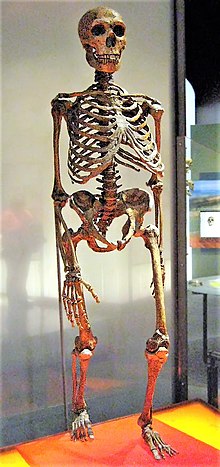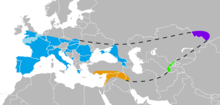Neandertal
An Neanderthals (/niˈændərˌtɑːl, neɪ-, -ˌθɑːl/ nee-AN-də(r)-TAHL, nay-, -THAHL;[7] Homo neanderthalensis or H. sapiens neanderthalensis), pigsusurat man bilang Neandertals, iyo an sarong extinct na espesye o subespesye kan archaic humans na nakaistar sa Eurasya sagkod sa haros 40,000 na taon an nakaagi.[8][9][10][11] An type specimen, Neanderthal 1, nanompongan kaidtong 1856 sa Neander Valley sa presenteng aldaw na Alemanya.
| Neanderthal Temporal range: Middle to Late Pleistocene 0.43–0.04 Ma PreЄ Є O S D C P T J K Pg N ↓ | |
|---|---|
 | |
| An approximate reconstruction of a Neanderthal skeleton. The central rib-cage (including the sternum) and parts of the pelvis are from modern humans. | |
| Sayantipiko na klasipikasyon | |
| Missing taxonomy template (pakarhayon): | Homo |
| Espesyes: | †H. neanderthalensis |
| Ngaran binomyal | |
| †Homo neanderthalensis King, 1864 | |
 | |
| Known Neanderthal range in Europe (blue), Southwest Asia (orange), Uzbekistan (green), and the Altai Mountains (violet) | |
| Sinonimo[6] | |
Homo
Palaeoanthropus Protanthropus
Acanthropus
| |
Toltolan
🔥 Top keywords: Panginot na PahinaAgrikulturaGOMBURZACarles PuigdemontManggaIkaduwang Gerang PankinabanDemokrasyaAdolf HitlerAratilisPatolaMarie AntoinetteKomunismoMoro-moroEspesyal:HanaponEnot na Gerang OpyoEkonomiyaPrayleDuhatAtisBuriBatang-XLapayKomedyaNobelaAlmoranasKasoyKalakalang GalyonPabo (hayop)RelihiyonKulugoSantanMakopaEspiritwalidadPagiArteMultoJosé RizalManokButanding
